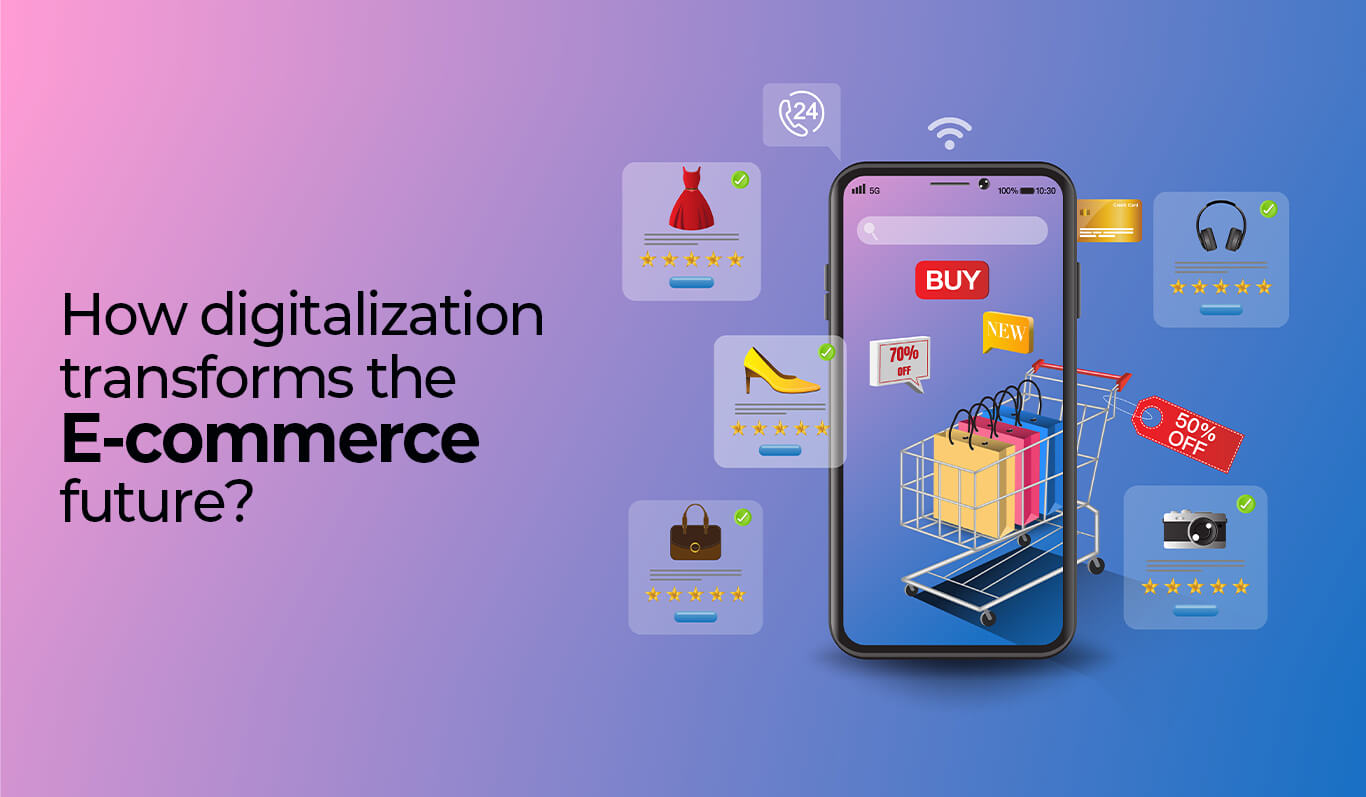How Digital Transformation Is Shaping the Future of eCommerce

E-commerce digital transformation is utilizing digital technologies in scaling the business to the next level. It is to uplevel the customer experience by taking market insights. The forecasted data revealed about digitally transformed companies will account for $53.3 trillion in global GDP in 2023. It clearly shows the supremacy of using digital strategies in global economic growth. E-commerce enterprises need to stay updated with the latest trends focusing on customer expectations and behavior. Then, considering such data insights take quick decisions in revamping the digital strategies.
- Increased DTC Sales
E-commerce companies can reach out direct customers through innovative digital strategies. It enables them to get a better understanding of customer expectations. Then, the enterprises can develop strategies focusing to increase customers and revenue. A dedicated chatbot system is beneficial to interact with customers directly. It enhances brand visibility and customer experience.
- Big Data Personalization
It is easy to get a personalized experience by using the technologies of big data, machine learning, and artificial intelligence. Give relevant product recommendations to the customers by analyzing them through big data algorithms.
- Product Optimization
The e-commerce sector's growth depends on data and product optimization. Boost the future of the e-commerce enterprise by understanding conversion rates and product optimizations. The dependence of e-commerce is on product conversions.
- Enormous use of mobile shopping
The customer is mobile shopping addicted to the attractive mobile interface, easy shopping, and ability to make great choices. The expected rise in the mobile retail sector will reach $728 billion by 2025. US contribution is 44% in the enormous business growth with the retail digital transformation.
- Visualization in augmented reality
Many retailers started using augmented reality to give better shopping experiences to customers. It increases the possibility to earn brand loyalty from customers making the business grow. The real-life solutions providers are confident customers will purchase the product that they make. They know customer preferences through real-time market insights through digital transformation.
Attaining digital transformation in e-commerce business
Now, we understood through the data insights how digital transformation is driving e-commerce business growth. Let us focus on preparing the strategies for executing digitalization in e-commerce sector.
Step 1: Defining business goals
The redesign of e-commerce can happen by considering the strategy outcome increases business profits. The widely accepted areas required for redefining business goals are:
- Apply a customer-centric approach to increase productivity
- Build robust infrastructure for flexible operations
- Get better business insights using strong analytical tools
- Control the cost by choosing effective technologies enhancing productivity
Step 2: Consulting e-commerce development company
E-commerce development agency consultation helps get detailed insights into e-commerce app development. The dedicated team can tell you about the cost, app platform, features, and app development duration based on the requirements.

Step 3: Develop robust strategies targeting customers
The prime focus of the e-commerce strategy is to focus on customer experience. The robust strategy framework and proper execution can benefit targeting maximum customers. Additionally, the e-commerce agency needs to keep its major focus on UI/UX implementations in the applications.
Step 4: Implementing relevant technology solutions
The technical stack needs to be based on the business requirements to get desirable results. Try to understand the in-depth features of the technology while implementing them in the e-commerce business.
Step 5: Give a real-life shopping experience to customers
Online customers are looking for a real-life shopping experience through e-commerce sites. AR and VR technologies adoption can broadly give a customized shopping experience to customers at all-time. The implementation of such a technology is possible by working on the existing framework. It saves time to create anything from the scratch.
Top trends in the digital transformation of retail business
Stay ahead in the competitive landscape by focusing to find the latest trends to grow your e-commerce business. The main purpose is to attract maximum customers to the retail business and make more profits.
- Automation
Businesses of all sectors started adopting automation to execute their operations efficiently. Therefore, the e-commerce sector is to expand its horizons in automating processes. E-commerce enterprises covering its every department from marketing, supply chain, warehousing, and inventory management. Keep the supply chain management in an automated mode so that there is no inventory shortfall in the business. Better lead generation and conversions by executing marketing strategies. Furthermore, marketing automation helped 77% of marketers get 56% more leads and conversions for the business.
- Chatbots
Chatbots and AI benefitted from making a prominent place in the digital transformation to cloud processes. Give personalized experiences to customers by handling their queries on time. The statistics data revealed that the e-commerce sector is receiving the maximum requests from chatbot responses. 34% of the users feel that a chatbot is a suitable tool for them submitting queries to retail businesses. They received a better experience as the executives of the e-commerce agencies handled the queries.
- Developing interactive products to attract customers
The e-commerce industry can focus to develop an attractive product range for customers. It can be done using augmented reality technology. Customers can make judgments on the brands and products available in the virtual world. The stats showed that more than 61% of customers are interested to choose products offering them the AR experience.
- Focus on promoting a business on social media
Social networking platforms Facebook, Instagram, and Twitter for product promotions of e-commerce businesses. E-commerce businesses can increase the target customer number through social media business promotions. Apart from that, social media use extended to product delivery and online payments. Such trends showed a high trajectory on Facebook can maximize its revenue of $2.9 trillion by 2026 against the estimated sales valued at $992 billion.
- BNBL (Buy Now Pay Later)
Most millennials are highly interested in availing of the Buy Now Pay Later (BNBL) option. Such an option offers flexibility and freedom to the young generations with multiple benefits. They can get the benefit to save interest on credit card payments. A report suggested the BNBL industry growth rate of $ 680 million by 2025.
- Use Progressive Web Applications (PWA)
The big e-commerce giants Walmart and Alibaba can make maximum profits by implementing the use of the PWAs. The implementations of the PWAs are effective to increase the conversion rate by 93%. It is possible by using the technologies JavaScript, CSS, and HTML for building software solutions for e-commerce businesses. These technologies give access to push notifications, offline application access, and access through smartphone screens.
Conclusion
Applying the right digital innovation approach executed accurately is helpful for service digitalization in e-commerce. Consider restructuring the strategies and business goals while implementing the business. Such e-commerce digital transformation can enhance the customer experience increasing the retention rates online. Online users can get viewing a wide product variety at their preference levels.
Frequently Asked Questions (FAQs)
Why digital transformation is important for e-commerce?
More than 79% of smartphone users make purchases through mobile apps. Therefore, retailers need to gear up to get in the game by using innovative technology solutions. Enterprises can start using digital strategies to stay relevant in the e-commerce sector for a long.
What are technologies used to execute digital transformation in e-commerce?
The list of highly recommended technologies is AI personalization, AR and VR product visualization, data analytics, and interconnectivity. The use of such technologies can help scale the business to the next level.
How to implement successful digitalization in e-commerce business?
The companies can follow the strategies helpful for the successful execution of digitalization in e-commerce.
- Defining business goals
- Consult with an e-commerce app development company
- Rebuild the customer marketing strategy
- Implement new technical solutions
- Use AR and VR technologies for strengthening customer experience
Request a Quote
Categories
Popular posts
Best Practices for Software Product Engineering Every CTO Should Implement
2023-14-18How to Build Your Own On-Demand Carpooling App Services?
2023-08-25How to Start an On-Demand Fuel Delivery Business: A Comprehensive Guide
2023-07-28Empowering Miners: How Fleet Management Apps are Transforming the Mining Industry?
2023-07-21A Complete Guide to Develop a Food Delivery App for Restaurants in 2023
2023-07-08Mobile Apps Transforming the Travel Industry: A Game-Changer in Travel Planning and Experience
2023-07-07
